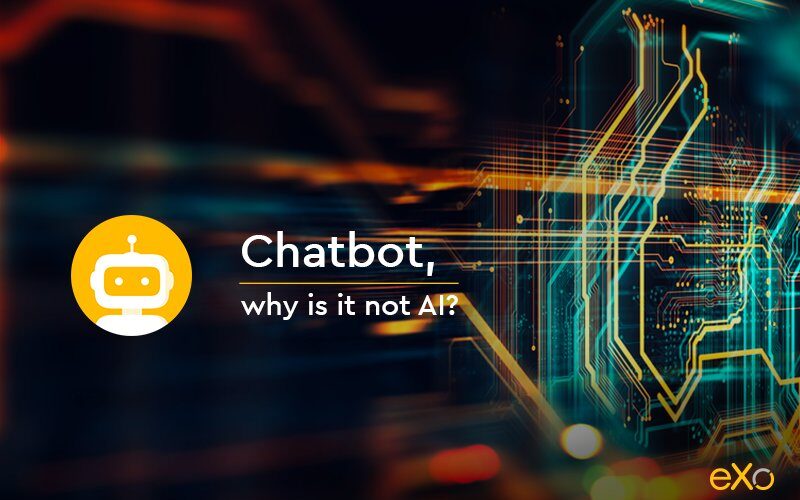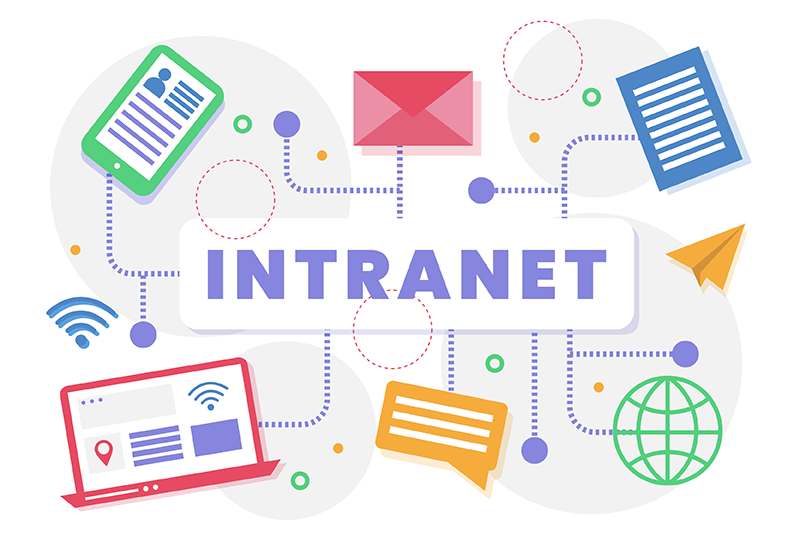- Walid Hamrouni
- June 14, 2018
Chatbot: Why it is not AI?
According to Stanford Researcher, John McCarthy, “Artificial Intelligence is the science and engineering of making intelligent machines, especially intelligent computer programs. Artificial Intelligence is related to the similar task of using computers to understand human intelligence, but AI does not have to confine itself to methods that are biologically observable.”

Content
In other words, AI’s aims at making computers and/or computer programs smart enough to replicate the human mind.
On the other hand, Chatbots are programs that interact with humans via text or voice interface. Chatbots can be compared to personal assistants. You nowadays find them in any major chat applications like Facebook Messenger, Slack, Text Messages, etc.
1. What are Chatbots?
Messaging platforms are at their prime, and the use of Chatbots is the new trend. Presented as the new disruptive technology for the communication industry, “Chatbots” has become the new buzzword.
In the 90’s “bots” (short for ‘robots’) were automated programs that run over the web. Some of them were running automatically while others only executed commands when they received a specific input. Chat bots were one of the first types of automated programs to hit the market under the name “bots” and were pretty popular in the 90’s, as online chat rooms knew their peak. However these bots were scripts that looked for a certain text pattern to respond online chat rooms participants with automated actions.
Since then, Chatbots have evolved with the addition of artificial intelligence systems that interact with humans via text or voice interface. Some say that both “Chatbots” and “Virtual Assistants” are the same, others disagree, however what you call it isn’t important, it’s all about the function. Both of them are more “intelligent” than a simple bot. As we said earlier, bots only follow scripts, while a chatbot is able to look for more options to interpret a command. Because of the support of artificial intelligence, they can actually understand the meaning of what was typed or said. In addition, you can also connect them to additional sources of information for their use, such as a CRM, real-time insights etc.
You can have straightforward interactions, like asking for the latest news, or getting a weather report instead of browsing them. Or you can have more complex bots that could for example troubleshoot a problem with your internet service. The purpose of Chatbots is to help you find anything you look for, without having to go through the web or the use of multiple apps. You may consider them as personal assistant that could for instance, allow you to call your Uber cab directly from Facebook Messenger instead of going through the Uber app.
Nowadays we can find bots for different types of fields or information such as:
- Weather
- Food
- News
- E-commerce
- Sales & Marketing
- Banking
- Customer Service
- HR & Operations
Bots offers you unlimited possibilities, indeed you can make bots for any kind of system in order to diminish pain points and work.
discover all the features and benefits
2. How do they work?
Nevertheless, Chatbots are not that “intelligent”, they are able to answer the questions that we ask for because humans make them do so with their input. What they do is that they recognize keywords from a user’s input, look into their database in order to give a predefined response. Let’s say that a user sends a text containing the word “car”, the chatbot will recognize the keyword “car” and will likely to answer “What is the model of your car?” or “Can you give me more information about your car?”.
Thanks to these responses, an illusion of understanding is created, even though only one keyword is found in the input, and the response is predefined. However, working with an experienced ai chatbot development company can help create more sophisticated chatbots that utilize advanced natural language processing and machine learning techniques to provide more accurate and contextually relevant responses. Basically, chatbots refers to predefined set of libraries and APIs appended to them, to fetch the correspondent set of patterns they can respond with. Chatbots function on pattern-matching, how “smart” the Chatbot will be depends on how human-like these predefined patterns are, and on its ability to understand the user’s text (or voice).
Also, some AI Chatbots development do include Machine Learning components. These advanced Chatbots understand not only commands but also language, plus they get smarter by learning from every conversations they hold with people.
You may also like:
3. What’s the opportunity for Chatbots?
Messaging apps are taking over social medias. In fact, with the rise of messaging apps and chatbots, how we interact, use and share on social media is changing. Studies have shown that for smartphones users condense their time using their favorites apps (browser, social media, chat and games). Plus, with opportunities narrowing down in the mobile apps business, developers are looking forward for chatbots as a new path.


FREE WHITE PAPER
for the Enterprise
4. What are the challenges for Chatbots?
However, the challenge here is how to process the huge amount of data about customer behaviors and preferences. On a technical level, there is a need of a human input to train the AI bot about what is being asked and how to solve the request. On a second note, with the enforcement of the General Data Regulation Protection (GDPR) law, there are some items that need to be addressed.
- When the processing of data is based on obtaining consent: The data controller must be able to demonstrate that the data subject has given his consent. The burden of proof therefore lies on the controller. It is then necessary to ask yourself if the simple fact for the user to exploit a chatbot amounts to a consent on his part. But then, what consent when the Turing test will be a success: the user will be unable to distinguish the robot from a human. A good practice could be setting up a banner as for websites in order to inform the user of the collection of his personal data with a possibility for the interlocutor to oppose it.
- The collection of sensitive data such as political opinions, religious beliefs, information about the sex life or health of the user. The particular nature of these data imposes additional obligations. For example, health data must be stored at an authorized hosting provider for this purpose.
- Data retention period: The data must be kept for a limited period. This duration is estimated in the light of the purpose of the processing. There are several situations to distinguish:
- For a chatbot designed to answer a user’s questions at a time T and provide a standardized answer: there is no reason to keep the user’s data for a long time ;
- For a deep learning chatbot that needs data to implement algorithmic processing: a longer retention period can be defined, in accordance with regulations and standards in force.
- Respect for users’ rights (rectification, deletion, data portability): The chatbot user must remain in control of his data. Like any system that uses personal data, the controller must ensure that the user’s rights over his or her personal data are respected and provide for the procedures for exercising these rights.
With the development of chatbots feeding on a multitude of data, it is important to ensure the compliance of the processing performed. It is also necessary to ensure the protection of the privacy of users, the chatbot should not be led to communicate the data of his interlocutor without the consent of the latter and for a purpose other than that expected by the user. Companies setting up chatbots must finally ensure that their service provider, subcontractor within the meaning of the GDPR, complies with its various requirements.
To conclude, most chatbots work on pattern-matching, their intelligence is limited compared to what AI can offer. Even though some advanced chatbots may include AI components or Machine learning, these capacities only allow them to understand language as commands more than being actually “smart”. They can nevertheless, offer numerous opportunities for developers as well as businesses to ease the customer experience
company intranet
Related posts
- All
- eXo
- Digital workplace
- Employee engagement
- Open source
- Future of work
- Internal communication
- Collaboration
- News
- intranet
- workplace
- Knowledge management
- Employee experience
- Employee productivity
- onboarding
- Employee recognition
- Change management
- Cartoon
- Digital transformation
- Infographic
- Remote work
- Industry trends
- Product News
- Thought leadership
- Tips & Tricks
- Tutorial
- Uncategorized
Leave a Reply
( Your e-mail address will not be published)



A very nicely written article, but, you never articulated why a Chatbot is or is not an artificial intelligence other than Chatbots operate via pattern matching and pattern matching is, in your opinion, limited. By definition, “…an artificial intelligence is a set of technologies that enables a machine to sense, comprehend, and react…”, .
At the very core of any artificial intelligence is the notion of comprehension via categorization, where the category is a n-dimensional model (a pattern) and a logic (if-then, Boolean, 1st -order, etc.) then applied in response.
The limits you speak of with Chatbots, are a constraint of the activity the Chatbot is undertaking. You would not want a Chatbot with the job of providing customer support for an electronic device or routing a phone call to the correct person in a call center to have the ability to discuss the works of philosopher, Martin Heidegger.
Chatbots have very simple artificial intelligences, they are as complex as they need to be for the jobs that they do. They are indeed AI’s, they are just relatively simple form of an AI, but an AI nonetheless.